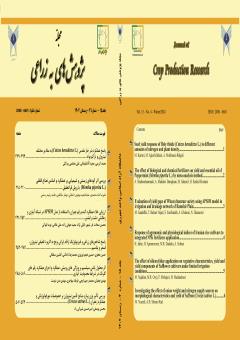پاسخ عملکرد بذر خار مقدس (Cnicus benedictus L.) به مقادیر مختلف نیتروژن و تراکم بوته
محورهای موضوعی : پژوهش های به زراعیمحمد کریمی 1 , مجید آقا علیخانی 2 * , علی مختصی بیدگلی 3
1 - دانش آموخته کارشناسی ارشد، گروه زراعت دانشکده کشاورزی، دانشگاه تربیت مدرس، تهران، ایران
2 - دانشگاه تربیت مدرس دانشکده کشاورزی
3 - استاد گروه زراعت، دانشکده کشاورزی، دانشگاه تربیت مدرس، تهران، ایران
کلید واژه:
چکیده مقاله :
به منظور بررسی پاسخ رشد و عملکرد دانه گیاه دارویی خار مقدس (Cnicus benedictus L.) به تراکم بوته و مقدار نیتروژن، آزمايشی در مزرعه تحقیقاتی دانشکده کشاورزی دانشگاه تربیت مدرس بهصورت کرت¬های خرد شده در قالب طرح بلوک¬های کامل تصادفی با سه تکرار انجام شد. عوامل مورد بررسي در اين آزمايش شامل چهار مقدار کود نیتروژن (صفر ،50، 100 و 150 کیلوگرم در هکتار) به عنوان عامل اصلی و چهار تراکم بوته (100، 150، 200 و 250 هزار بوته در هکتار) به عنوان عامل فرعی بودند. در زمان رسيدگي فیزیولوژیک وزن تر و خشك ساقه، برگ، عملکرد و اجزای عملکرد دانه و شاخص برداشت تعيين شدند. نتایج نشان داد که اثر متقابل تراکم و نیتروژن برای تمامی صفات کمی اندازه¬گیری شده به جز تعداد شاخه فرعی در بوته و تعداد دانه در طبق معنی¬دار بود. کود نیتروژن بر صفات تعداد طبق در بوته و تعداد دانه در طبق اثر معنی¬داری داشت. درمجموع تیمار تراکم 10 بوته در متر مربع در اکثر مقادیر نیتروژن بیشترین عملکرد دانه و اجزای عملکرد را سبب شد. بر این اساس برای تولید بذر خارمقدس به منظور توسعه سطح زیر کشت این گیاه دارویی ارزشمند پیشنهاد می¬شود از کشت¬های متراکم که معمولا برای تولید حداکثر پیکر رویشی گیاه توصیه شده اند اجتناب شود زیرا بر اساس یافته¬های این پژوهش، تشدید رقابت دورن گونه¬ای در تراکم-های بالاتر از 10 بوته در مترمربع موجب کاهش معنی¬دار عملکرد دانه خواهد شد.
In order to investigate the response of the growth and seed yield of the holy thistle (Cnicus benedictus L.) to the plant density and nitrogen rate, an experiment was conducted in the research farm of the Faculty of Agriculture of Tarbiat Modares University. Experimental treatments were arranged in split plots based on randomized complete block design with three replications. The investigated factors in this experiment included four nitrogen rates (0, 50, 100 and 150 kg. ha-1) as the main factor and four plant densities (100, 150, 200 and 250 thousand plants per hectare) as sub factor. At the time of physiological ripening, fresh and dry weight of stem, leaf, seed yield and yield components and harvest index were determined. The results showed that density × nitrogen interaction effect was significant for all measured quantitative traits except the number of sub-branches per plant and the seed number per plant. Nitrogen fertilizer had a significant effect on the disk number per plant and seed number per disk. In total, the density treatment of 10 plants per square meter caused the highest seed yield and yield components in most nitrogen rates. Based on this, for the seed production of holy thistle in order to develop the cultivated area of this valuable medicinal plant, it is suggested to avoid dense cultivations, which are usually recommended to produce the maximum vegetative body of the plant, because according to the findings of this research, the intensification of inter-species competition in density higher than 10 plants per square meter will cause a significant decrease in seed yield.

